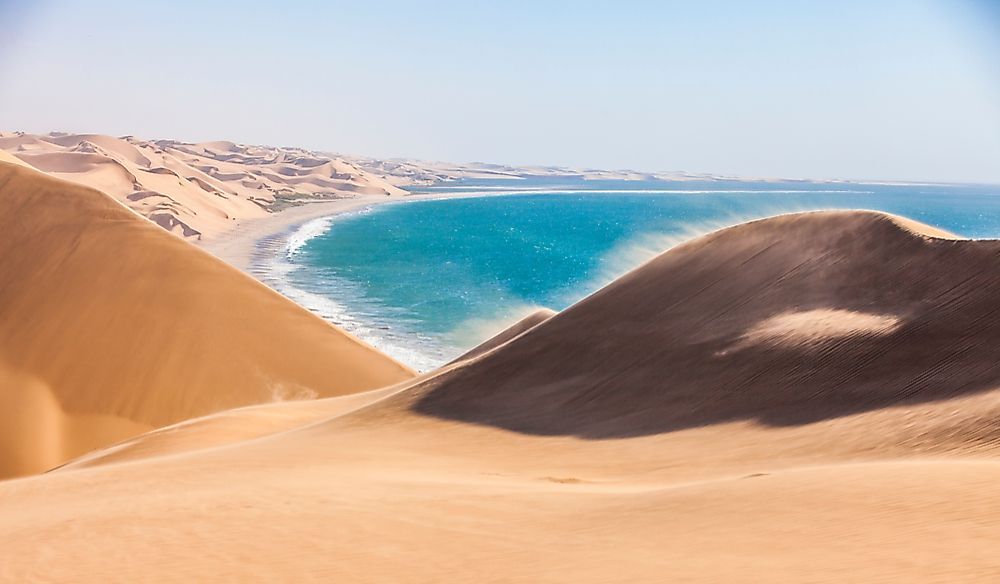Top 10 Interesting Facts About Namibia

Namibia is a country in Southern Africa, which borders Zambia and Angola to the north, Botswana to the east, South Africa to the southeast, and to the west has an extensive coastline along the Atlantic Ocean. With a total area of 825,615 km2 and population of 2,606,971, it is one of the world’s most sparsely populated countries. Nevertheless, Namibia features numerous natural and cultural attractions, some of which are highlighted below.
10. Namibia Is the Driest Country in Sub-Saharan Africa
The climate of Namibia is extremely dry and arid, receiving an average annual rainfall of about 350 mm. The northeastern part of the country experiences the greatest amount of precipitation, while the southwestern part of the country is the driest, receiving up to 600 mm and as little as 50 mm of rain each year, respectively. Most parts of Namibia lack perennial rivers, and therefore the population is dependent on groundwater as a water supply.
9. The World’s Oldest Desert Is Located in Namibia
The Namib Desert is a coastal desert in Southern Africa and is considered to be the world’s oldest desert. It has a total distance of about 2,000 km and covers parts of Angola, Namibia, and South Africa.
8. Africa’s Largest Canyon Is Located in Namibia
The Fish River Canyon is the largest canyon in Africa and is one of Namibia’s many natural wonders. It is located in the southern part of the country and is Namibia's second most visited tourist destination. The canyon has a gigantic ravine, which has a total length of 160 km, a maximum width of 27 km, and a maximum depth of nearly 550 m. The canyon is formed by the Fish River as it passes through the arid, stony, plateau landscape.
7. Namibia Has the World’s Largest Wild Cheetah and Black Rhino Populations
Namibia was the first country in Africa to integrate environmental protections into its constitution. Today, the country boasts of the world’s largest populations of cheetahs and free-roaming black rhinos.
6. The Deadly Skeleton Coast Is Located in Namibia
Part of Namibia's coastline along the Atlantic Ocean has been named the Skeleton Coast. This stretch of coastline, located in the northern part of Namibia and the southern part of Angola, is covered by dense ocean fog throughout the year, which is caused by upwelling of the cold Benguela current. Within the region, winds blow from land to sea, the coast receives very little rainfall, and beaches are subject to constant, powerful surfs. Historically, it was nearly impossible to launch boats from the shore, and the only way out to the ocean was through a vast marsh that was only accessible through a hot and arid desert. Given its harsh conditions, the Skeleton Coast has been responsible for numerous deadly shipwrecks.
5. Namibia Features the World’s Largest Non-Subglacial Underground Lake
The Dragon’s Breath Cave is a cave located in the Kalahari Desert, within the Otjozondjupa Region of Namibia. Discovered in 1986, the cave was named after the moist air that rises from its entrance. Located approximately 100 m below the surface, the cave also contains the world’s largest non-subglacial underground lake, which occupies an area of roughly 4.9 acres.
4. Namibia Is the World’s Second Least Densely Populated Country
With a population of only 3.2 persons per square kilometers, Namibia is the world’s second least densely populated nation.
3. Namibia Has the World’s Largest Meteorite
The Hoba meteorite is the world’s largest meteorite. Discovered near Grootfontein, Namibia in 1920, it is believed to have fallen to Earth approximately 80,000 years back and weighs 54,000 kg.
2. Some of the World’s Highest Sand Dunes Can Be Found in Namibia
Located in the southern part of the Namib Desert, Sossusvlei is a massive salt and clay pan surrounded by some of the world’s highest sand dunes. Many of these dunes are more than 200 m tall, and the largest has a height of 325 m. Sand dunes with even greater heights exist in Namibia. For example, Dune 7, which is located near Walvis Bay, reaches a height of 383 m and is the country’s highest sand dune.
1. Namibia Has One of Africa’s Largest Concentrations of Rock Petroglyphs
Located in Namibia's Kunene Region, Twyfelfontein has one of the continent’s largest concentrations of rock engravings and art. The area has likely been inhabited for 6,000 years, and the site has been designated as a UNESCO World Heritage Site. It is believed that ancient hunter-gatherers, and later herders, who lived in the area conducted shamanist rituals that involved creating the rock carvings that remain today.











